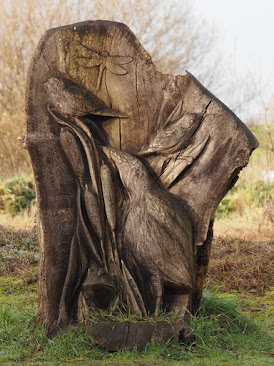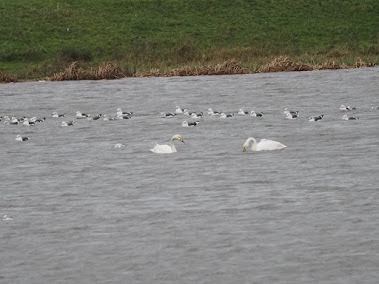Lakenheath Fen is an inspiring place. What was once carrot fields is now a huge wetland, a huge new area of reedbed as far as the eye can see. An area that used to hold no life is a bustling reserve, home to rare birds like bitterns, marsh harriers and even cranes. What had gone was not lost, nature can return if given the chance. Lakenheath Fen, then, is a beacon of light to a nature depleted countryside.
However Lakenheath is also an extremely difficult place to birdwatch. From a bird watchers point of view its really hard to get any views of birds. The acres of reeds that make the reserve so important also has its drawbacks. There is just no way to see what's hiding in the long grass as reedbed birds are notoriously shy. There is no focal point to the reserve, no place at which to see the birds, an area that brings the birds closer to the bird watcher. All the viewpoints look over a long landscape of reeds with views all the way to the horizon.
What I'm thinking about is like an Island Mere at Minsmere, where a hide overlooks a large lake in the reeds, a great place to see bitterns, hobbies and marsh harriers. But there isn't such a place like that at Lakenheath. So on a windy day in December, all the birds were laying low, and I saw few birds.
Its a long slog covering the reserve. The area is huge and travelling to the different viewpoints means miles of walking. At the centre there were large numbers of birds on the feeders, including a pair of REED BUNTINGS, not your usual garden birds. However as I left the centre that was the last time I saw any birds...
Apart from the sea of reeds the other notable habitat on the reserve is the poplar plantations. Planted in the 50s to provide timber to make matchsticks, these woods are the last surviving reminder of what the land used to be. Gradually the trees are getting blown down or dying and are being replaced naturally by scrub, to in turn revert to natural woodland. These areas were the last place nesting place of the golden orioles in this country, a tiny population that never properly colonised the UK. The plantations are not of natural species and don't really provide much interest bird-wise.
The first real feel of the place is provided by New Fen, the first area of reeds created on the reserve, which is a large chunk of reedbed buffeted by poplar woods on three sides and the river on the other. Nothing much was showing in the wind, so leaving here it was another slog down to Mere Hide. This hide overlooks a small pool in an area of reeds. Previously I've seen bearded tits, hobbies and water rail here but today there wasn't anything to be seen, which was the standard for the day.
The final viewpoint, Joist Fen, is positioned halfway through the reserve, a couple of miles from the centre. The viewpoint overlooks the rest of the reserve, a huge area of reeds shimmering to the horizon. The problem with this viewpoint is that the only way to see any birds is if they are in flight as the long reeds hide what's lurking beneath. Today there were just a couple of female MARSH HARRIERS about, quartering the area in pursuit of game beneath.
From Joist Fen the path takes on a loop, returning to the centre. On this part of the walk the path follows the river, a large meandering water snake, called the Little Ouse. This river is the life blood of the area, a highway for wildlife. Keeping with the theme of the day there wasn't much about, a WATER PIPT and a pair of STONECHAT were on the river back, along with a small charm of GOLDFINCHES.
Eventually the path headed to the Washland a large area of seasonally flooded water. Now this is the focal point I have been talking about on the reserve. If they provided few more areas like this at Lakenheath, then I think it would make it better for birdwatching, and bring in more birders to the reserve. As it was the area was disappointing, as there were no ducks, just a pair of WHOOPER SWAN, with decent numbers of roosting LESSER BLACK BACKED and BLACK HEADED GULLS. A GREAT WHITE EGRET was hunting along the river here, a now normal bird, this reserve has become the county stronghold of the species. Just beyond, a little up the river, there were three CHINESE WATER DEER, an escapee that originates from China, that's found a niche for itself here, and is most welcome. From here it was a short walk back to the centre and the car park, calling it an end for the day.
So that's it, that's all I saw in today's visit. And trust me that was through a three hour slog around the reserve. Now I support the RSPB totally, and I don't mind walking to eventually see birds, but when there's nothing to see it can be a bit demoralising. What is needed at Lakenheath is a focal point to the reserve, an area where birds can be seen, any birds, which would greatly increase its attractiveness to bird watchers. There are undoubtedly birds present, there's just no way of seeing them. But as always the RSPB does a great job, that should never be forgotten and in creating this reserve they have done a great service to nature.








No comments:
Post a Comment